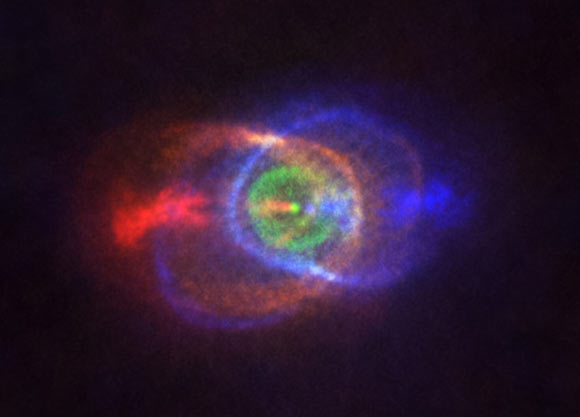Astronomers Probe Peculiar Binary System: HD 101584 | Astronomy – Sci-News.com
There is growing evidence that evolution of red giant stars is often affected by an interplay with a nearby companion. Using the Atacama Large Millimeter/submillimeter Array (ALMA) and ESO’s Atacama Pathfinder EXperiment (APEX), astronomers have now observed a beautiful nebula that resulted from a confrontation between a red giant and its lower-mass partner.

This ALMA image shows the outcome of a stellar fight: a complex and stunning gas environment surrounding the binary system HD 101584. The colors represent speed, going from blue (gas moving the fastest towards us) to red (gas moving the fastest away from us). Jets, almost along the line of sight, propel the material in blue and red. The stars in the binary are located at the single bright dot at the center of the ring-like structure shown in green, which is moving with the same velocity as the system as a whole along the line of sight. Astronomers believe this ring has its origin in the material ejected as the lower mass star in the binary spiraled towards its red-giant partner. Image credit: ALMA / ESO / NAOJ / NRAO / Olofsson et al / Robert Cumming.
The binary system in question, called HD 101584, resides 6,806 light-years in the constellation of Centaurus.
The main star is a red giant; the secondary is a red dwarf or possibly a low-luminosity white dwarf, which orbits the red giant every 150-200 days.
“In HD 101584, a nearby low-mass companion star was engulfed by the giant,” said Dr. Hans Olofsson, an astronomer at the Chalmers University of Technology.
As the main star in HD 101584 puffed up into a red giant, it grew large enough to swallow its lower-mass partner.
In response, the smaller star spiraled in towards the giant’s core but didn’t collide with it.
Rather, this maneuver triggered the larger star into an outburst, leaving its gas layers dramatically scattered and its core exposed.
“The complex structure of the gas in the HD 101584 nebula is due to the smaller star’s spiraling towards the red giant, as well as to the jets of gas that formed in this process,” Dr. Olofsson and colleagues said.
“As a deadly blow to the already defeated gas layers, these jets blasted through the previously ejected material, forming the rings of gas and the bright bluish and reddish blobs seen in the nebula.”
“Currently, we can describe the death processes common to many Sun-like stars, but we cannot explain why or exactly how they happen,” said Dr. Sofia Ramstedt, an astronomer at Uppsala University.
“HD 101584 gives us important clues to solve this puzzle since it is currently in a short transitional phase between better studied evolutionary stages.”
“With detailed images of the environment of HD 101584 we can make the connection between the giant star it was before, and the stellar remnant it will soon become.”
The results are published in the journal Astronomy & Astrophysics.
_____
H. Olofsson et al. 2019. HD 101584: circumstellar characteristics and evolutionary status. A&A 623, A153; doi: 10.1051/0004-6361/201834897





